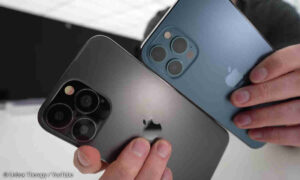The iPhone 15 Pro and 15 Pro Max both have USB-C compatibility, meaning that it is possible to capture ProRes videos directly onto an external storage device. This is huge for any person who wants to shoot professional video on your phone.
Also, it can support log encoding to improve the dynamic range when video editing. This is important for amateur filmmakers or anyone else who wishes to use their iPhone as a b-camera in larger projects.
ProRAW as well ProRes editing for video
The iPhone 15 Pro and the iPhone 15 Pro Max both feature Apple’s premium ProRes video codec. Unlike raw uncompressed video, which can take up a large amount of space, ProRes compresses the video to a smaller size without sacrificing quality.
It is also possible to record ProRes videos directly onto the smartphone’s storage on the external, instead of using internal storage. Apple says this will allow longer recording durations and greater freedom to film when on the move.
New models are able to capture ProRes both in 4K as well as HD at 60fps. This allows you to record additional action from the field as well as provide higher-quality footage to edit in the future. Additionally, the phones support Log as well as Dolby Vision HDR.

A16 bionic chips performance
The A16 Bionic chip inside the apple iphone 15 pro is a beast of a processor. It’s capable of competing with- and often outperforms -some of the most powerful Android phones on the market which includes Samsung’s Galaxy S23 and OnePlus 11.
In a single Geekbench test, which measures general performance, the A16 Bionic produces some of the best numbers to be seen on an iPhone. It beats even the new Snapdragon 8 Generation 2 on the multicore part of the test.
This is thanks to the CPU configuration of the A16’s six cores that’s 10% quicker than the previous. It also has a 6-core GPU that is 20% more efficient and can support hardware-accelerated ray tracing. The whole thing is running one-third less power than rivals such as that of Snapdragon 8 Gen 1 and MediaTek Dimensity 9000. While this isn’t a revolutionary technology yet it proves that Apple has the ability to maintain an advantage in smartphones’ chipsets.
Super Retina XDR display
The iPhone 15 Pro and the Pro Max feature a Super Retina XDR display that runs at 120Hz ProMotion. Apple declares it to be the fastest mobile-grade refresh rate of any smartphone.
It allows editors of video to work with high-definition videos and photos with more clarity. It also helps with fast game play and a smoother experience.
Another big update is the main camera. It includes a 48MP sensor and has lossless optical zoom that can be set at 3x and 5x. It can capture depth information in addition, and both the cameras in front can be capable of producing portraits without the need to switch to Portrait mode.
Apple has also introduced a brand new Spatial Video capture feature that combine the ultra-wide and main cameras to create a 3D video. They can later be played back on the upcoming Vision Pro headset.
Editing apps
Apple’s new iPhone 15 Pro models boast several features that could appeal for video creators. They include a Pro Camera system and support for 4K60 ProRes video recording. In addition iPhone 15 Pro iPhone 15 Pro has an improved LTPO display with an adaptive refresh rate of up to 120Hz.
Apple has also taken away the mute slider on its Pro devices and replaced it with a versatile Action button which can be customized to launch apps, record voices, or execute shortcuts. It also has more customizable widgets on its always-on screen.
It is also equipped with much more storage capacity in comparison to the previous models, beginning with 256GB before soaring with 1TB. It’s also compatible with Apple’s upcoming Apple Vision Pro headset, that will let users create immersive and spatially-focused videos.
5G connections
The iPhone 15 Pro supports 5G connection for seamless collaboration creating content. This ensures high-quality streaming, video conferencing, as well as speedier downloads of larger files.
The new model also offers new features that boost its appeal to videographers. As an example, it’s able to capture 4K ProRes at 60 frames per second onto external storage. Additionally, it has a second-generation Ultra Wideband chip for improved capabilities in location services.
A further benefit for content creators is the shift to USB-C. It reduces the amount of Lightning accessories you need to keep track of. It also allows the transfer of data at speeds as high as 10Gbps. This is a huge advancement over the 480Mbps Lightning is capable of delivering.